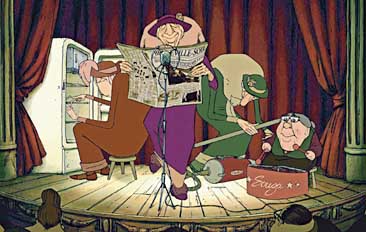 • I acquired an eleven-year-old nephew when I married Mrs. T, an experience that is giving me a new perspective on the world of art and culture. Ian is old enough to be curious about adult entertainment, so we’ve been trying to introduce him to a somewhat higher class of movie than he’s accustomed to seeing, with mixed but not unpromising results (he liked The Triplets of Belleville but not Shane). A few weeks ago we took him to his first Shakespeare play, A Midsummer Night’s Dream, to which he responded with enthusiasm, though we ran into a bit of trouble at intermission when he caught sight of a poster advertising a production of Tennessee Williams’ The Night of the Iguana. He immediately assumed that it was a play about giant iguanas and demanded that I tell him all about it. “You’re not quite ready for that one, buddy,” I replied.
• I acquired an eleven-year-old nephew when I married Mrs. T, an experience that is giving me a new perspective on the world of art and culture. Ian is old enough to be curious about adult entertainment, so we’ve been trying to introduce him to a somewhat higher class of movie than he’s accustomed to seeing, with mixed but not unpromising results (he liked The Triplets of Belleville but not Shane). A few weeks ago we took him to his first Shakespeare play, A Midsummer Night’s Dream, to which he responded with enthusiasm, though we ran into a bit of trouble at intermission when he caught sight of a poster advertising a production of Tennessee Williams’ The Night of the Iguana. He immediately assumed that it was a play about giant iguanas and demanded that I tell him all about it. “You’re not quite ready for that one, buddy,” I replied.
In recent months Ian has been taking an interest in classical music, and asked if I could burn him a CD containing some of the pieces he’d heard. He specifically asked for Beethoven’s “Für Elise” and the first movement of the Fifth Symphony, Rossini’s Barber of Seville and William Tell Overtures, Tchaikovsky’s 1812 Overture, On the Beautiful Blue Danube, and Grieg’s “Morning” (from Peer Gynt). I told him I’d be happy to oblige, and threw in for good measure the first movement of the “Moonlight” Sonata, Mozart’s Marriage of Figaro Overture, Dukas’ Sorcerer’s Apprentice, Rimsky-Korsakov’s “Flight of the Bumblebee,” Sousa’s “The Stars and Stripes Forever,” and Leroy Anderson’s “The Syncopated Clock.”
I heard all of these pieces for the first time in elementary school, back in the long-forgotten days of music-appreciation classes, and they made a deep and lasting impression on me, no doubt because of their picturesque qualities. It will be interesting to see whether and how a postmodern child responds to them.
